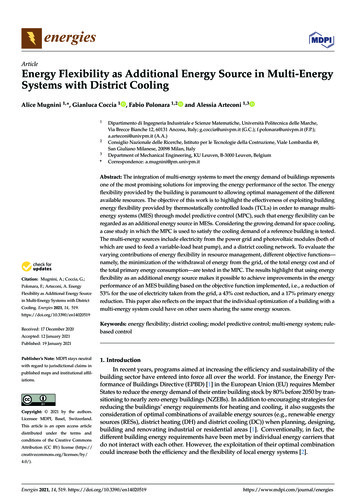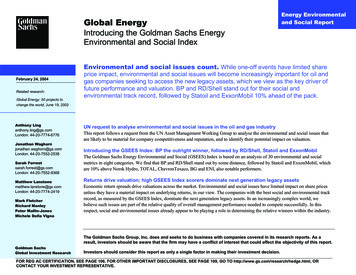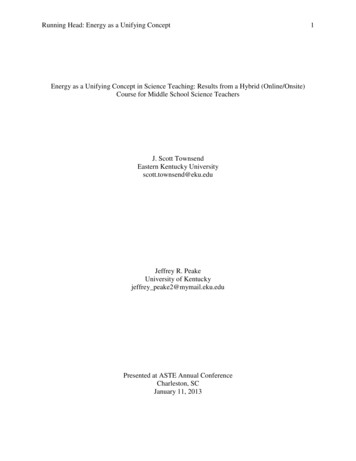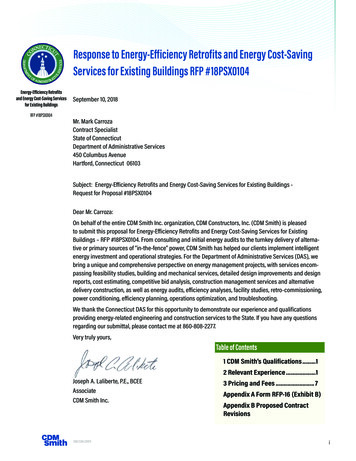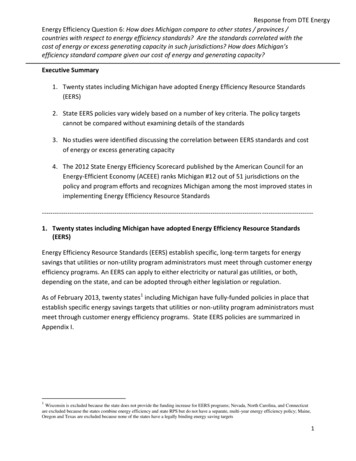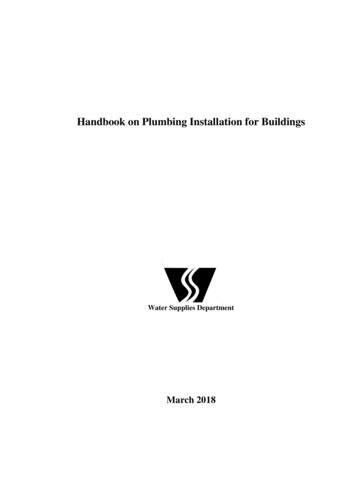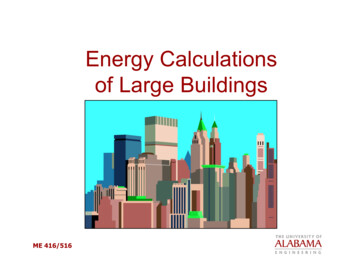
Transcription
Energy Calculationsof Large BuildingsME 416/516
Recall how we calculatedresidential loads. For residential heat loss through envelope, used:q A T/Rwhere R is the effective, overall R-value for thelayers through which heat is transferred. For summer heat gain through envelope, used:q A CLTD/Rwhere CLTD is the effective "cooling loadtemperature difference" that accounts for outsidesurface heating by the sun.ME 416/516
Large Building Load Calcs. For large buildings, conventional to use:q U A T or q U A CLTD U is the effective overall heat transfercoefficient. Comparing relations that use R to those that useU,U 1/Ri.e., overall heat transfer coefficient is simply thereciprocal of effective R-value.ME 416/516
Seasonal PerformanceMeasures To simplify energy calculations, we useratings that give an average efficiency overan entire heating or cooling season. We’veseen: AFUE- Annual Fuel Utilization Efficiency fora fossil fuel fired furnace or water heater. HSPF- Heating Seasonal PerformanceFactor for an electric heat pump. SEER- Seasonal Energy Efficiency Ratio forelectric cooling equipment.ME 416/516
What’s Wrong with SeasonalMeasures? The main problem with these ratingsis that they do not account forequipment performance variationsthat occur hourly in response tochanges in the weather. The design of HVAC systems forlarger buildings requires a moresophisticated energy calculationprocedure to account for variationsin performance.ME 416/516
The Bin Method The "bin method" refers to a procedure wheremonthly weather data is sorted into discretegroups (bins) of weather conditions. Each bin contains the number of average hoursof occurrence during a month or year of aparticular range of weather condition. Example: The city of Tideville has the followingdry bulb temperature bin data for the month ofApril:ME 416/516
ME 0-5445-4940-4435-3930-3425-29
Bin Data The top row of the table indicates that April averages 2hours when Tdb is 80, 81, 82, 83 or 84 F, etc. The bin data are based on long-term weathermeasurements from National Weather Service. Similar bin tables are available for many weatherstations for parameters including Twb, mean coincidentTwb with Tdb, wind speed, solar insolation, rainfall, etc.,both monthly and annually. ASHRAE sells a CD-rom with much of the U.S. data,and NWS has a lot of data also (Web availability?)ME 416/516
Use of Bin Data Instead of using asingle design conditionfor an entire year, anengineer can calculateloads for each bincondition, multiply thebin load by the hoursof occurrence for thatbin, then sum the loadfor each bin to get thetotal load.ME 416/516Example: Find the Aprilheating load for abuilding in Tideville thatis kept at Ti 68 F andhas an overall value ofUA 112,000 Btu/hr- F,where q U A T.
TdbHours T( 4----------------611162126313641ME 416/516qQMBtuh 618.4Qtotal 1091
Bin Method Energy Calculations The previous example illustrates advantages of loadcalculation by the bin method. Although the example given showed a directly linearrelationship between T and q, there are cooling orheating loads that vary nonlinearly. Using the bin method results in a more accuratecalculation of the total load, Q. When the weather varies hour-by-hour, the demandput on the heating and cooling equipment varies,plus equipment performance varies at differentweather conditions.ME 416/516
Bin Method Accounts forWeather Effects BetterME 416/516 The accuracy of calculating theequipment energy use isimproved by using the binmethod even more than was theload calculation. For equipment that operates onthe refrigeration cycle, such asair conditioners and heat pumps,performance and capacitydepend strongly on the weather,for several reasons.
st1Weather Effect onEquipment PerformanceThe maximum possible efficiency of refrigerationcycle drops as T increases. For example, thetheoretical COP of a heat pump (heating) is:COPCarnot TH/(TH - TC) Here TH Ti and TC Tod. For Ti 67 F, the max.theoretical COP is about 26 for Tod 47 F but onlyabout 6.5 for Tod 17 F, a drop of 75%. Actual COP's are much lower COPCarnot. Standard90.1, for example, requires small heat pumps tohave COP 3 at 47 F and COP 2 at 17 F.ME 416/516
2nd Weather Effect: A/CCapacity Drops at High Tod A/C and heat pump capacity drops as T rises. In order to reject heat to hot outside air, an A/C,e.g., must have a condenser refrigerant temperaturesignificantly higher than Tod. As Tod rises, the compressor outlet pressure rises toreject heat. There is a limit to how much pressureincrease can be achieved by motor, so as outdoortemperature gets higher, the T between refrigerantand air gets smaller. Heat rejection, which is proportional to this T,drops, thereby reducing A/C capacity.ME 416/516
3rd Weather Effect: HP CapacityDrops at Low Tod Same capacity loss occurs for aheat pump (heating) as Toddrops, but the situation is worse. A heat pump also loses capacityin cold weather because it has togo into defrost mode, where itactually runs in reverse, blowingwarm air out through the outdoorunit to melt ice that has frozenon the coils during the normalmode of operation.ME 416/516
4th Weather Effect: Capacity isExceeded in Extreme Weather A final effect of weather conditions is that as Tincreases, the heating or cooling load risesproportionally, and at some point the machinecapacity is exceeded. For A/C, the building gets warmer. For heat pump, auxiliary "strip" resistance heat isactivated, working at COP 1. If the system is sized adequately, the thermalcapacity of the system will allow the building toflywheel through “normal” extreme weather withoutgetting excessively hot or cold.ME 416/516
Part-Load Performance A heating or cooling system (large or small)operates at only a fraction of its capacity most ofthe time, at the part-load condition. The part-load efficiency is less than full-loadbecause of transient losses, the need to reheator recool ductwork when the system comesback on, operation of pumps and fans at fullspeed when not needed, throttling losses, etc. The system efficiency is derated to account forreduced part-load performance.ME 416/516
Part-Load Derating Efficiency, e.g., COP, is derated at part load as:COPpart COPfull* CCAFwhereCCAF [1 - 0.25*( 1 - PLF)]and the part-load factor PLF is the fraction of fullload at which the system is operating:PLF Load/Capacity For periods where load exceeds capacity, thesystem operates at full capacity, PLF 1, andCCAF 1.ME 416/516
Bin MethodExample A building in Tideville has a heat pump thatoperates with the temperature dependent capacityand COP shown in the following table. The COP at part load operation is calculated as When the cooling load exceeds the heat pumpcapacity, auxiliary strip heat kicks in to make up thedifference. The strip heat has COP 1. Find the demand in kW for the system and themonthly energy use in kWh.ME 416/516
321827416/516 2.672.502.33
Tdb F827772676257524742373227ME 416/516Hours2143889115128106887543184qCapMBtuh 048411056111124
Notes on Bin Method Example No heating is done when temperature is above65 F (depending on internal heat sources, etc.,no heating may be necessary until Tod isconsiderably lower). "Cap." is the capacity (total heat input rate thatcan be provided) of the heat pump that isheating the building. Note that capacity drops asTod gets lower.ME 416/516
More Notes on Bin MethodExample The "kW" column is the electric power demandof the heat pump at a given condition, obtainedfrom:kW q (Btu/hr)/(COP * 3412 Btu/kWh)where q is the building load for conditions wherePLF 1 and q is the heat pump capacity forconditions where the heat pump is operatingcontinuously. The “kWh” column is the product of kW and thenumber of hours in a particular bin.ME 416/516
Tdb F827772676257524742373227HoursME 416/5162143889115128106887543184qCap.MBtuh 63.6 4770284.9 12250509.4 9169730.9 2924Total 29112
More Notes on Bin MethodExample The "Aux. kW" column is the demand of theauxiliary electrical resistance heater:Aux. kW (q - Cap.)/3412 Btu/kWh The “Aux. kWh” column is the product of theAux. kW column and the hours in a bin. The sum of the heat pump kWh and theauxiliary kWh gives the total heating energy usefor the month of April, which is 140,236 kWh.ME 416/516
theoretical COP of a heat pump (heating) is: COP Carnot T H/(T H-T C) Here T H T i and T C T od. For T i 67 F, the max. theoretical COP is about 26 for T od 47 F but only about 6.5 for T od 17 F, a drop of 75%. Actual COP's are much lower COP Carnot. Standard 90.1, for example, requires small heat pumps to have COP 3 at 47 F and COP 2 at 17 F.


